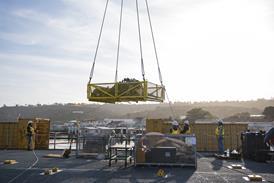The case for a new generation of larger 70-to 100-seat class regional jets is clear. But debate continues on the optimum cabin configuration, the degree of cross-family commonality and correct cockpit system philosophy. Much is riding on each of the manufacturers getting it.
The battle over aircraft cross-sections is the issue attracting the most airline attention. Bombardier and Fairchild have settled on similar size five-abreast cabins for their new BRJ-X and JET families. The difference is that the former is a double bubble cross-section and the latter is circular.
"This cross-section allows greater passenger space and gives us the biggest five-abreast cabin in the industry," claims Greg Mutch, Bombardier marketing and aircraft programmes senior manager. "While breadth is virtually identical, the BRJ-X has a measurably taller 2.09m (6'10") cabin and a deeper 1,020mm lower luggage hold, compared to the JET's respective 2.05m and 850mm dimensions.
Fairchild's baseline model is the 728JET, which it benchmarks not against BRJ-X but the much smaller CRJ-700. The aircraft's five-abreast cabin has been designed for maximum flexibility, accommodating 70 seats in a single-class 815mm pitch, or up to 80 seats in a 785mm pitch with the forward wardrobe and lavatory removed.
"Alternatively," says Fairchild senior director Roger Munt, "you can have a dual class 68-seat aircraft and still fall within the scope clauses. This is something that you cannot logically do with the ERJ-170 or CRJ-700 as they're four abreast. How do you get a first class in? Go to three abreast? The impact on economics is devastating."
Embraer counters that its four-abreast double bubble cross-section provides better all-round passenger comfort and more overhead bin space.
The aircraft's longer fuselage and two passenger doors forward and two rear doors ensures a faster turnaround time, claims ERJ-170/190 programme director Luis Carlos Affonso.
The broader the aircraft family's size, the harder it has been to maintain wing and engine commonality. The 728JET and 528JET will share a common 75m2 (805ft2)wing and 1.08m diameter General Electric CF34-8D1/3 engine, derated from 14,000lb-thrust (62kN) for the smaller aircraft. The 928JET will incorporate a larger wing, but use the "same hanging components", and 1.35m diameter, 17,000lb-thrust CF34-8DXX engine.
Embraer has met similar difficulties with the ERJ-170/190 wing and plans a wing root insert for the larger of the two aircraft. "We decided against commonality because we found the fuel performance and payload range was so important to company revenue it was better to optimise the wing for each of the models." says Affonso.
No decision has been taken on an engine, but a selection is expected during the Paris air show between the BMW Rolls-Royce BR710-50, CF34-8E and Snecma Pratt & Whitney SPW16. Bombardier is also to decide by the autumn on its choice of BRJ-X powerplant, with the BR715, CFM56-9 and PW6000 in contention. It plans a standard 101.3m2 wing for the two aircraft and is looking for common 19-22,000lb-thrust engine type, says Mutch.
Fairchild is so far the only company to have finalised its major suppliers and equipment, which will include the Honeywell Epic avionics suite with five liquid crystal displays and Lucas fly-by-wire (FBW) flight controls. It will include a pilot override and no sidestick. "The carriers told us they didn't want an Airbus-type system. They want the pilot kept in the loop and conventional controls," says Munt.
Bombardier says it is "leaning towards" an FBW system that incorporates active feedback on the yoke, saying it will make for easier cross crew qualification training. Embraer is undecided, says Affonso.
Source: Flight International























